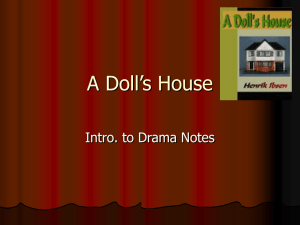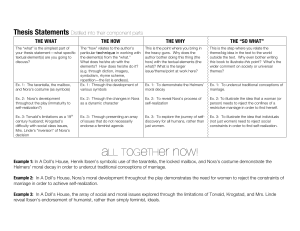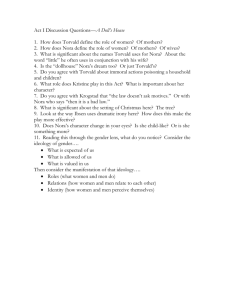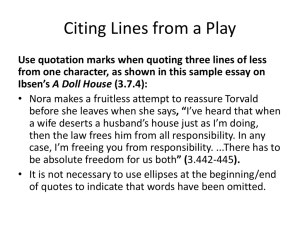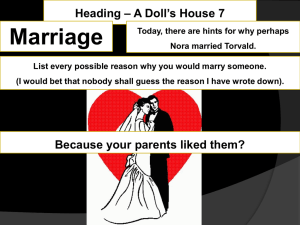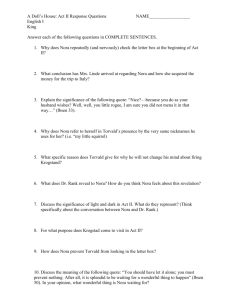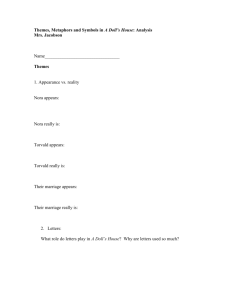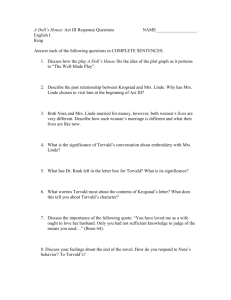A Doll's House notes
advertisement
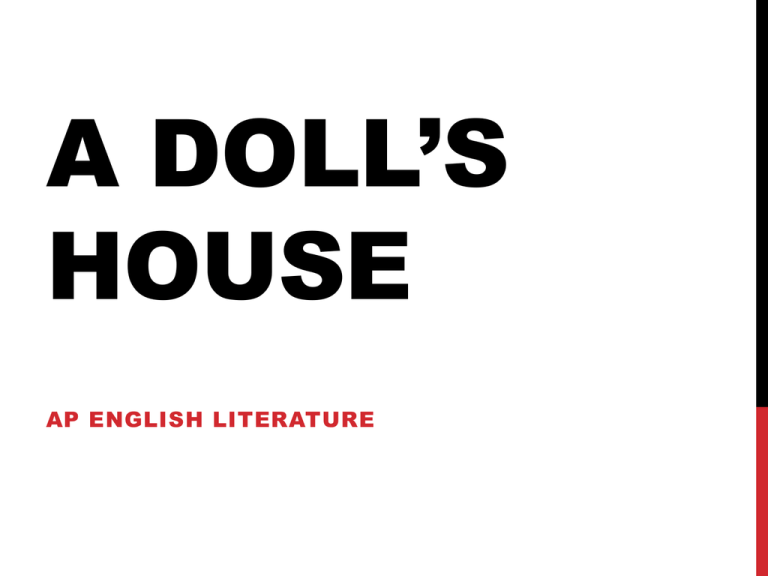
A DOLL’S HOUSE AP ENGLISH LITERATURE REALISM Attempts to create the appearance of life as it is actually experienced. Characters speak dialogue we might hear in our daily lives (not Shakespeare). These characters are not larger than life (Hamlet, Julius Caesar, Romeo), but are rather representative of it. Realism bring into focus commonplace, everyday life rather than the extraordinary events that make up works like Medea or Hamlet. Realistic characters may be heroic, but, like Nora, they find that their strength and courage are tested through events ordinary people might experience. FOCUS OF REALISM Work, death, marriage, children, love are often the focus of realistic dramas. Conflicts are likely to reflect common problems we face in our own lives. • Hence, making “ends meet” is more important than saving the kingdom • Realism in the 19th century paralleled the rise of the middle class eagerly seeking representation in the theater. • The only genuine comfort is in knowing the truth THE PROBLEM PLAY Popularized by Ibsen and his contemporaries. Represents a social issue in order to awaken the audience to it. Usually rejects romantic plots in favor of holding up a mirror that reflects not simply what audiences want to see, but what the playwright sees in them • What social issues are addressed in this play? • Gender issues • Rising middle class • ???? THE PLAY Dramatizes the tensions of the nineteenth-century middleclass marriage in which a wife struggles to step up beyond the limited identity imposed on her by her husband and society. It affirms the necessity of rejecting hypocrisy, complacency, cowardice, and stifling conventions in order for life to have dignity and meaning. THEMES OF THE PLAY Marriage Women and femininity Men and masculinity Respect and reputation Lies and deceit Money Love SYMBOLS IN THE PLAY • Christmas tree •Torvald's nicknames • The dance •Clothing change •Time change QUESTIONS FOR ACT I Review the opening exchange between Nora and Helmer. . . How are ideas of marriage different today than during the time period of the play? How are they similar? Can the Helmers' marriage be salvaged? How could the Helmers make their marriage equal? MOST COMMON CRITICAL APPROACHES Feminist New Historicism Archetypal or Mythological Marxist Psychological or Freudian A MARXIST APPROACH A principal tenet of Marxist criticism is that human consciousness is a product of social conditions and that human relationships are often subverted by and through economic conditions. • Mrs. Linde has sacrificed a genuine love to provide for her brothers. • Krogstad commits a crime to support his children. • Anne-Marie, the maid, has been a victim of her economic background. Because she’s a “girl who’s poor and gotten in trouble,” her economic security has been tested. • In each instance the need for money is linked with the ability to survive/exist. HOW IT AFFECTS THE PLAY Krogstad become less a traditional villain when we realize that he is fighting for his job. His realization about the senselessness of life is revealed when he reflects on Mrs. Linde’s past: “all this simply for money.” Notice how Dr. Rank speaks of his failing health in financial terms: “These past few days I’ve been auditing my internal accounts. Bankrupt! Within a month I’ll probably be laid out and rotting in the churchyard.” MONEY=HAPPINESS? All of these characters serve as foils for the essential struggle between Nora and Helmer and highlight the pilgrimage Nora must make in the play. At the outset, two things are clear: • 1. Nora is enslaved by Torvald in economic terms. • 2. She equates personal freedom with the acquisition of wealth. • Notice how happy Nora is at the beginning of the play—it’s Christmas and Torvald has just received a promotion and raise. • “Won’t it be lovely to have stacks of money and not a care in the world?” THE RESULT. . . Nora learns financial enslavement is symptomatic of other forms of enslavement—master-slave, male-female, sexual objectification, all of which characterize her relationship with Torvald; she also learns that money does not bring happiness. At the end of the play, she renounces not only her marriage but also her financial dependence because she has discovered that personal and human freedom are not measured in economic terms. This discovery prompts her to re-examine society and leads us to consider the ideology of the play. What change might Ibsen be attempting to bring about? FOOD FOR THOUGHT To what degree do you agree with the Marxist tenet that “consciousness is affected by economics”? CRITICAL PERSPECTIVES •addresses looking at literature beyond the typical plot-themecharacter- setting studies •is a way of criticizing or analyzing literature Literary theories emerged as ways to explain different people’s views and responses to literature. • No one view is the best or correct view • Values all views that are based on a careful study of the literature The benefit of a critical perspective : •more than one view gives a deeper understanding and appreciation READ P. 1762- 1763: NOTES FOR A DOLL’S HOUSE IN THE BEDFORD USE THE FOLLOWING CHART FOR JOURNAL #5. Practical life: Morality: MALE PERSPECTIVE FEMALE PERSPECTIVE • • • • READ P. 1768-1771: “A NINETEENTHCENTURY HUSBAND’S LETTER TO HIS WIFE” JOURNAL #6 Analyze this text using the Marxist perspective. To refresh this concept, use p. 1771-1773 in the Bedford.
